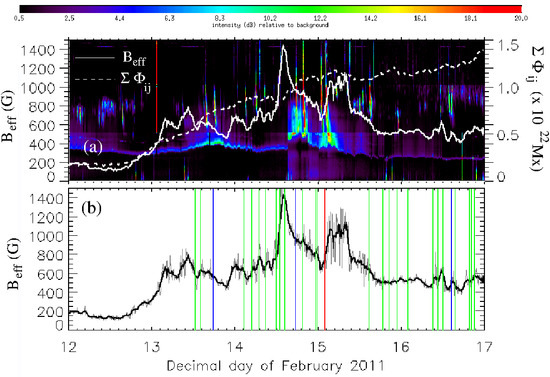Toward an Efficient Prediction of Solar Flares: Which Parameters, and How?
Abstract
:1. Introduction
2. The Data

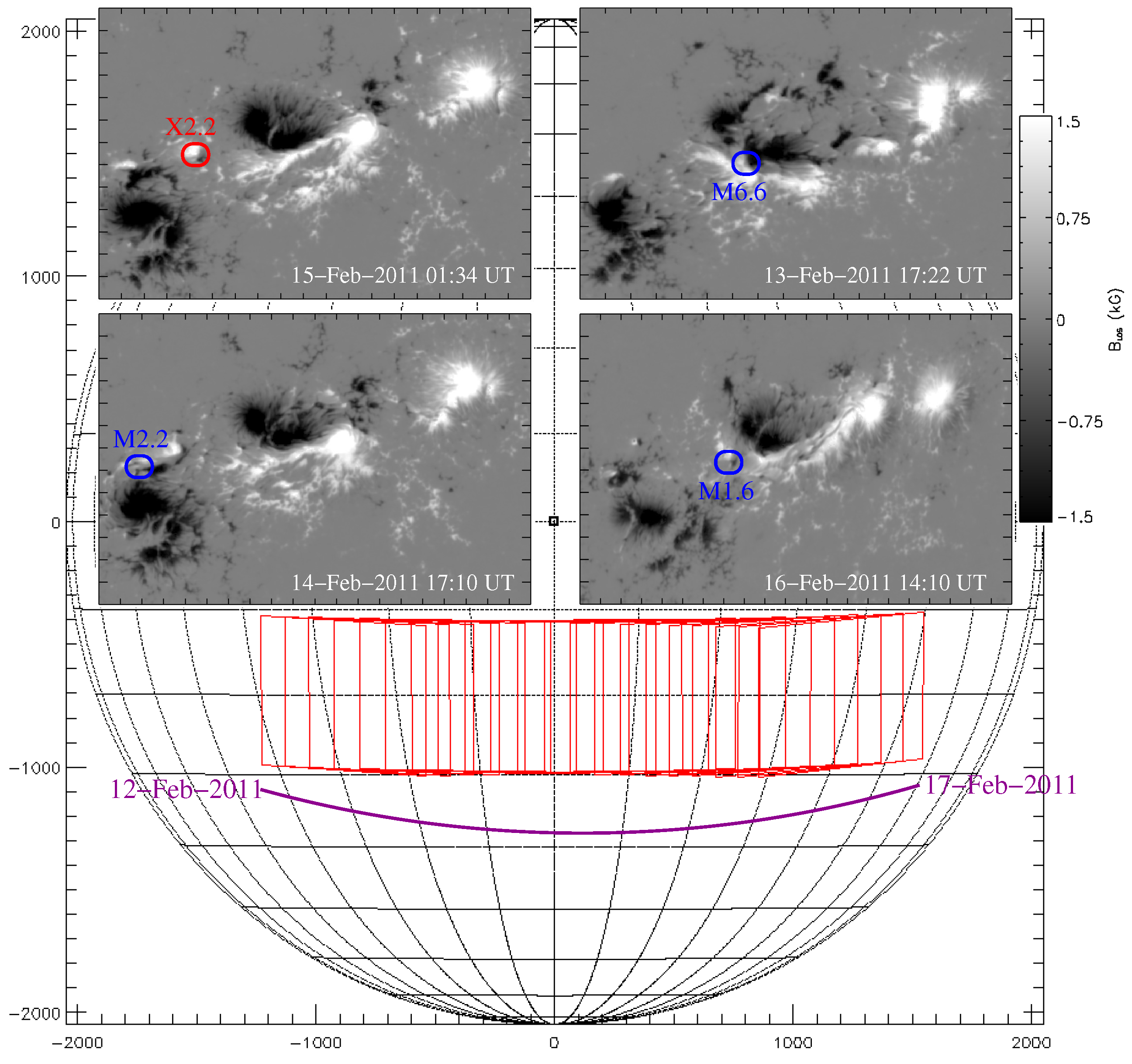
| Solar Object Locator | GOES type | GOES universal time (UT) | HEK approximate flare location | |||||
|---|---|---|---|---|---|---|---|---|
| Onset | Peak | End | XY (arcsec) | CMD/LAT (deg) | ||||
| SOL2011-02-15T01:44 | X2.2 | 01:44 | 01:46 | 02:06 | 156 | −226 | 9.86 | −20.16 |
| SOL2011-02-13T17:28 | M6.6 | 17:28 | 17:38 | 17:47 | −84 | −226 | −5.25 | −20.09 |
| SOL2011-02-14T17:20 | M2.2 | 17:20 | 17:26 | 17:32 | 58 | −231 | 3.63 | −20.45 |
| SOL2011-02-16T14:19 | M1.6 | 14:19 | 14:25 | 14:29 | 468 | −240 | 30.78 | −20.19 |
3. Classes of Flare-Predictive Diagnostics
3.1. Multiscale Parameters

3.2. A Proxy Parameter
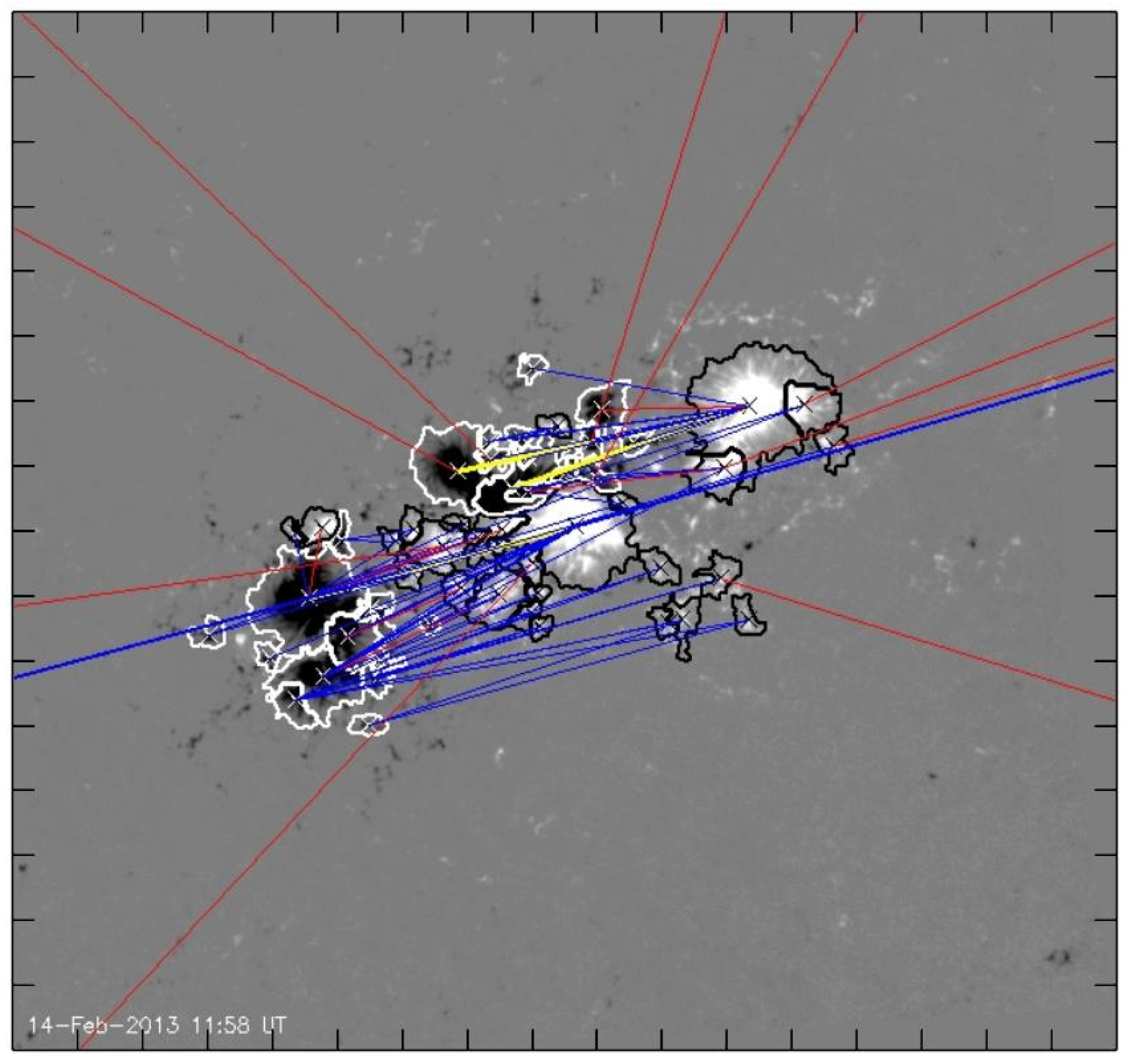
3.3. Fundamental Physical Parameters
4. Results and Discussion
4.1. Parameter Time Series over the Observing Interval
- (1)
- The fractal dimension, , (Figure 5b) shows a generally increasing trend throughout the entire interval. This trend is reminiscent of the increasing trend shown either by the total unsigned flux in the AR (see Figure 2 of [20]) or that of the total connected flux, , in the connectivity matrix (Figure 6a). This implies that may be directly proportional to the active-region flux, which is a result suggested by other studies, as well [63].
- (2)
- The scaling index, α, (Figure 5c), on the other hand, reaches a peak fairly early in the AR evolution (decimal days 13.5–14) and then starts decreasing nearly monotonically for the rest of the observing interval. Recalling that the flux in the AR is generally increasing in the same interval, this means that from February 14th onwards, turbulence in the AR becomes more robust, forming a “harder”, better established inertial range and moving toward “nominal” Kolmogorov values. The AR has yet to reach these values by the end of the observing period. Overlooking the dependence of α on spatial resolution [4], therefore, one would argue that the AR is characterized by non-Kolmogorov/non-Kraichnan turbulence for the entire observing interval. Only at very initial stages (decimal day ≤) do we obtain α-values closer to Kraichnan turbulence (). Further work on high-cadence data and, ideally, ARs observed from emergence to decay is required to understand this effect and its meaning; it might be that ARs start with a turbulence closer to MHD intermittent or HD values, but, in the course of their evolution, closely interacting magnetic partitions quickly quench this picture toward more complex patterns. In [4], virtually all studied ARs, be they flaring or non-flaring, show α-values far from the range . The authors of [34], on the other hand, seem to obtain α-values closer to this range mostly for unipolar sunspots and decaying ARs.
- (3)
- The intermittency index, , fluctuates around values 1.5–1.6 for most of the observing interval, namely between decimal days 12.6 and 15.6. For about a day, between days 14 and 15, we notice a significant decrease reaching up to values ∼1.4. Before decimal days 12.6 and after 15.6, -values are lower, around ∼1.4 for the former and nearly monotonically decreasing for the latter intervals, respectively. The decrease between decimal days 15.6 and 16.7 seems steeper than that of α, while for the last 8 h of the observing interval (decimal day >16.7) -values consistently start increasing again. At no time during the observing interval does become lower than 1.2, which means that, again overlooking the spatial-resolution dependence reported by [4], the magnetic field of the AR shows significant intermittency.
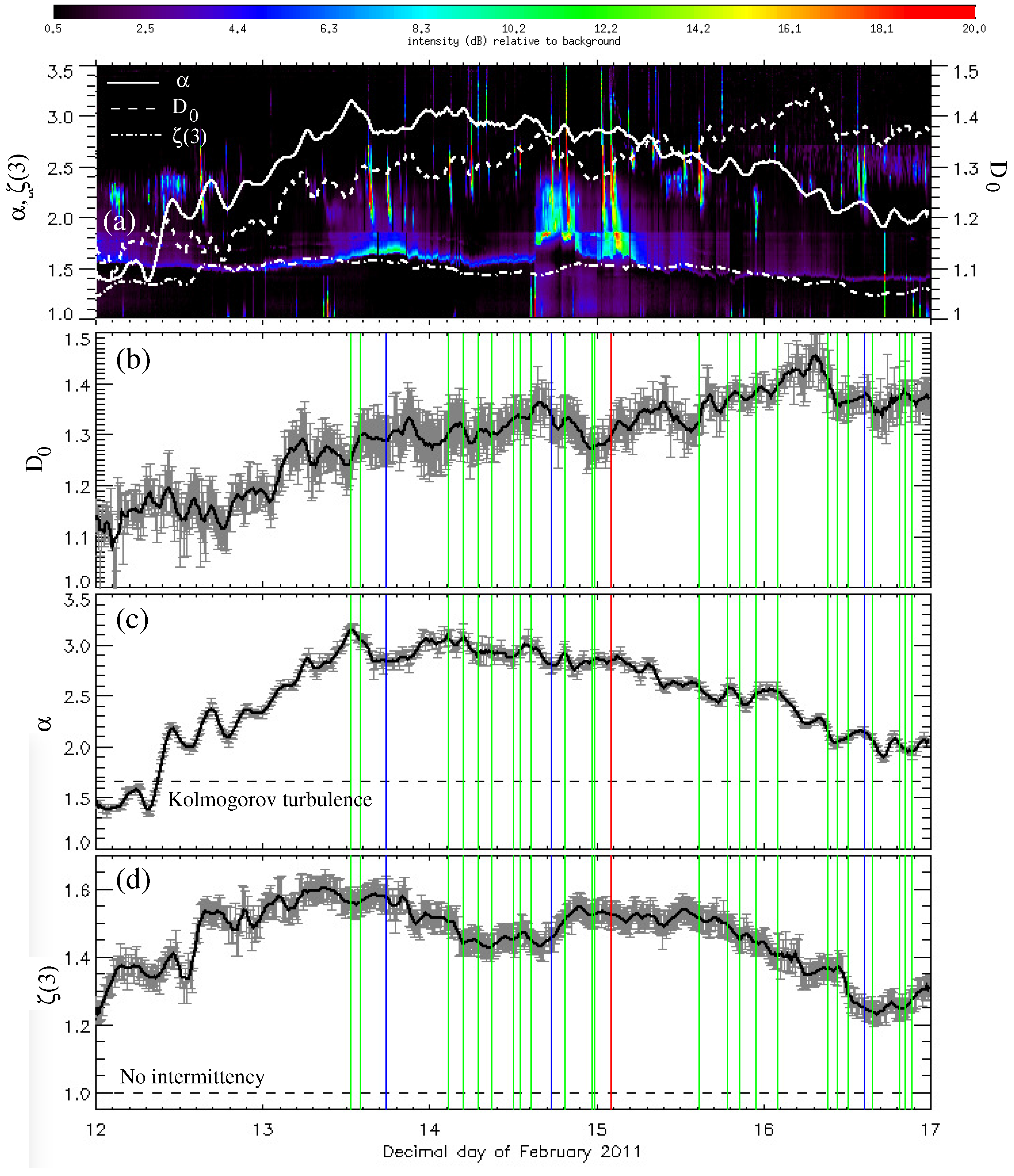
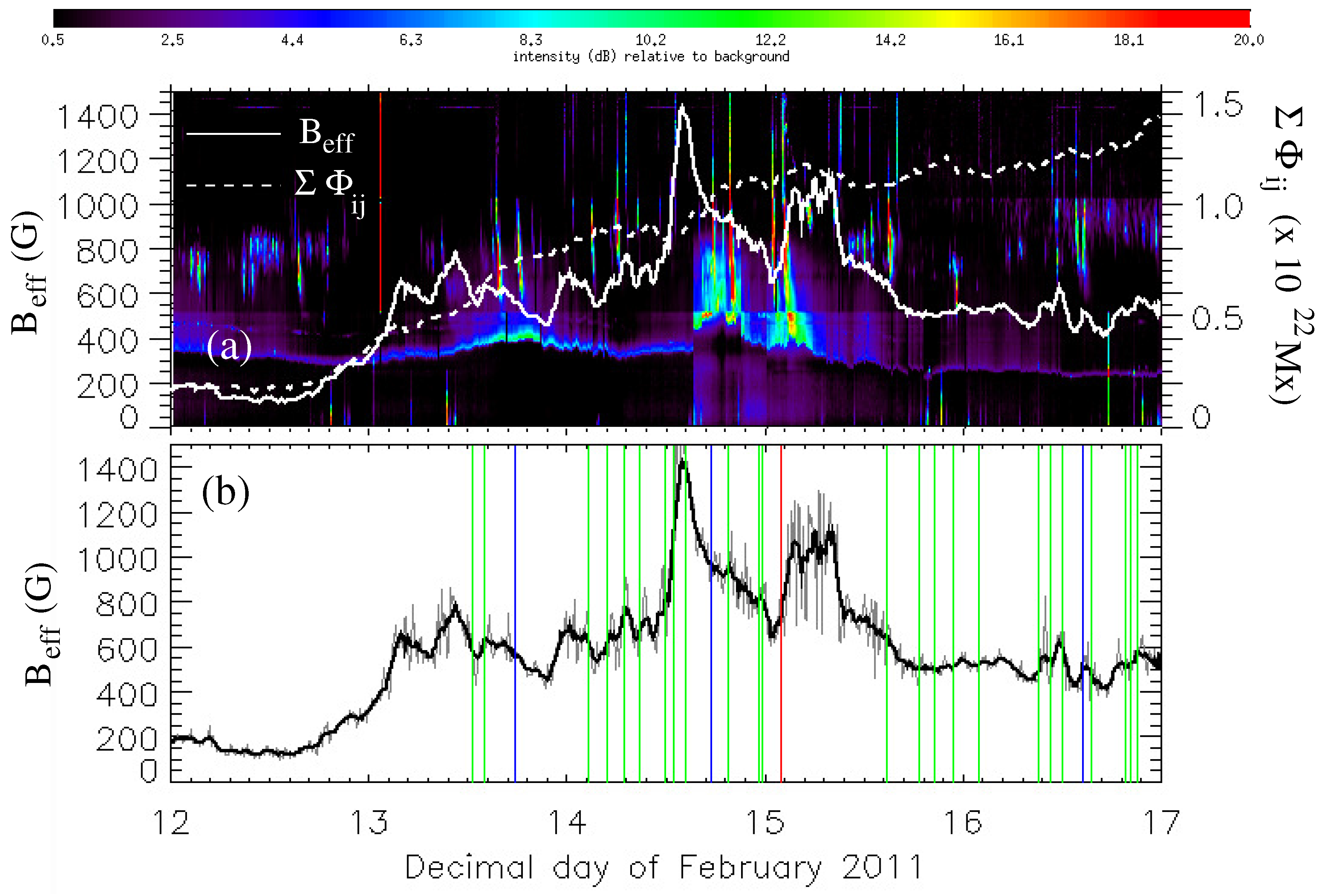
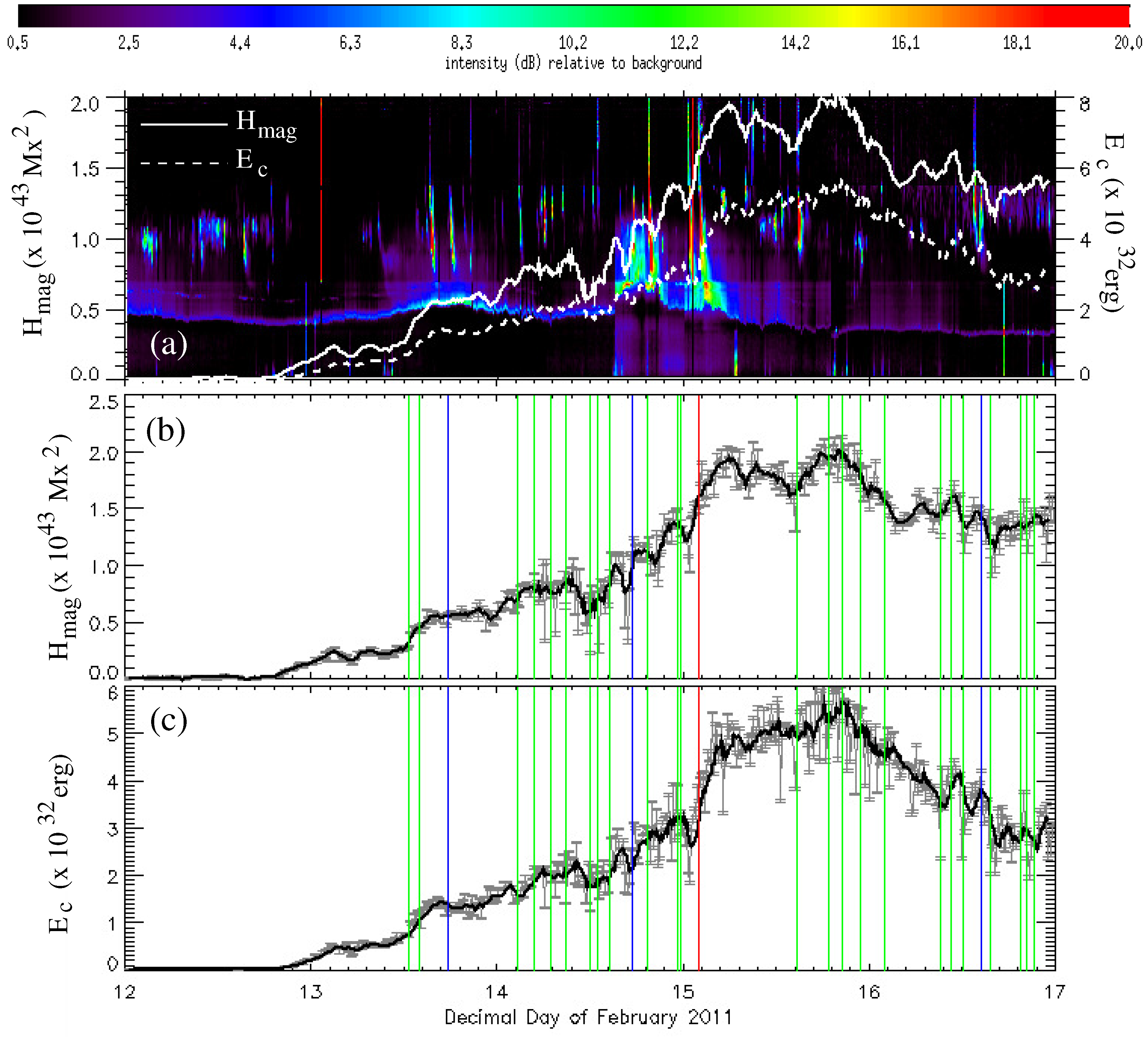
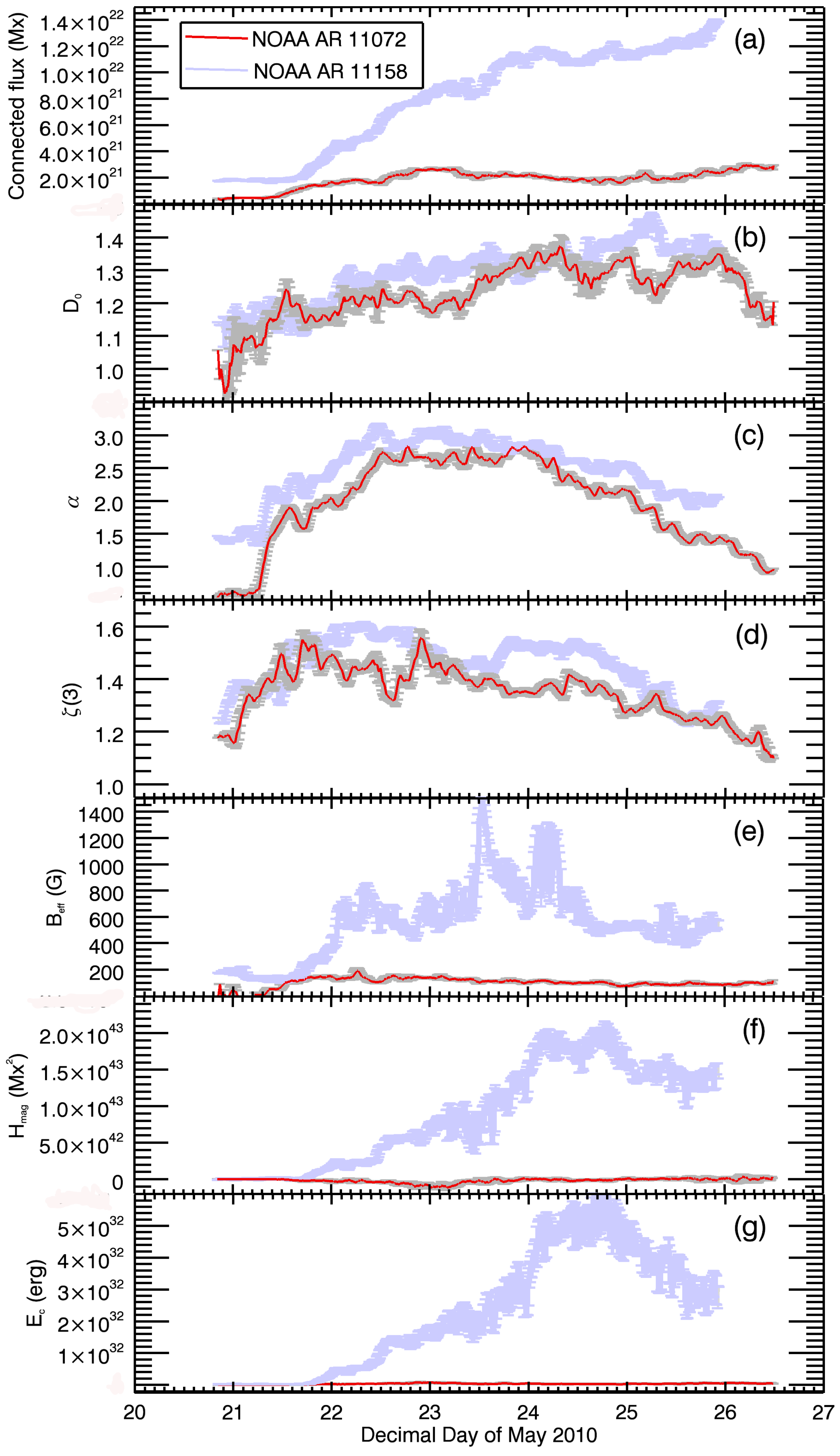
4.2. A Search for Possible Parameter Variations Prior to Flares
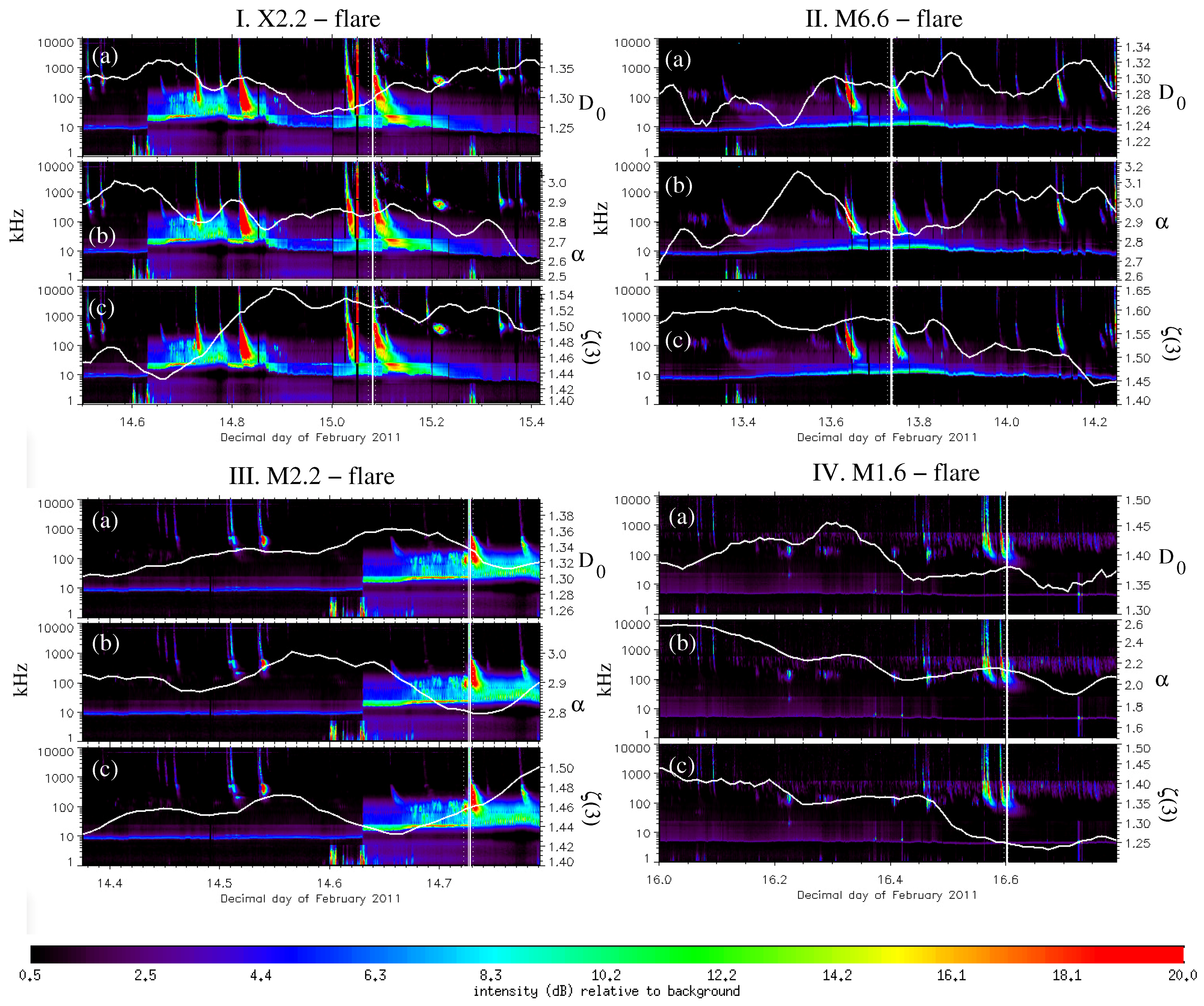
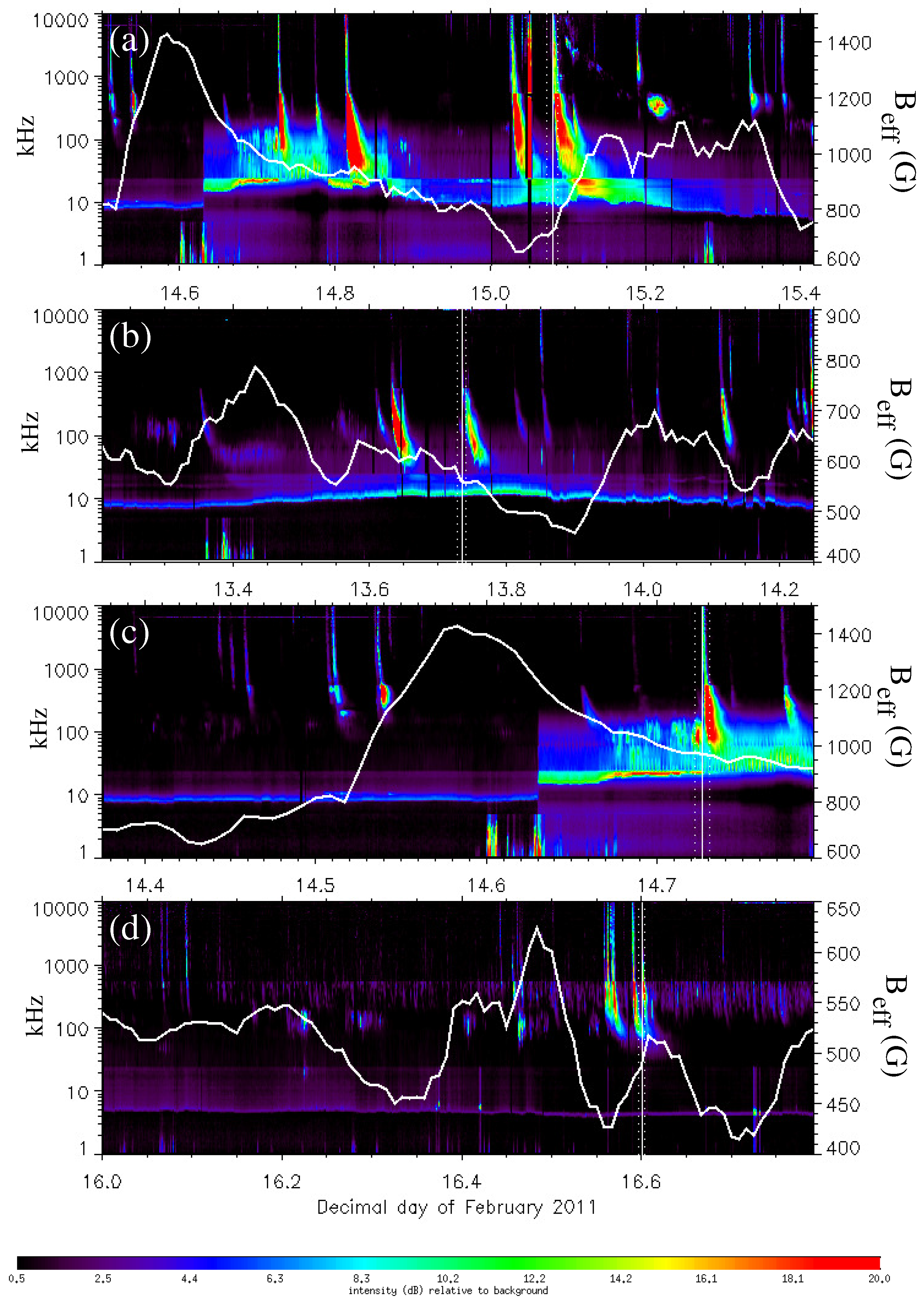
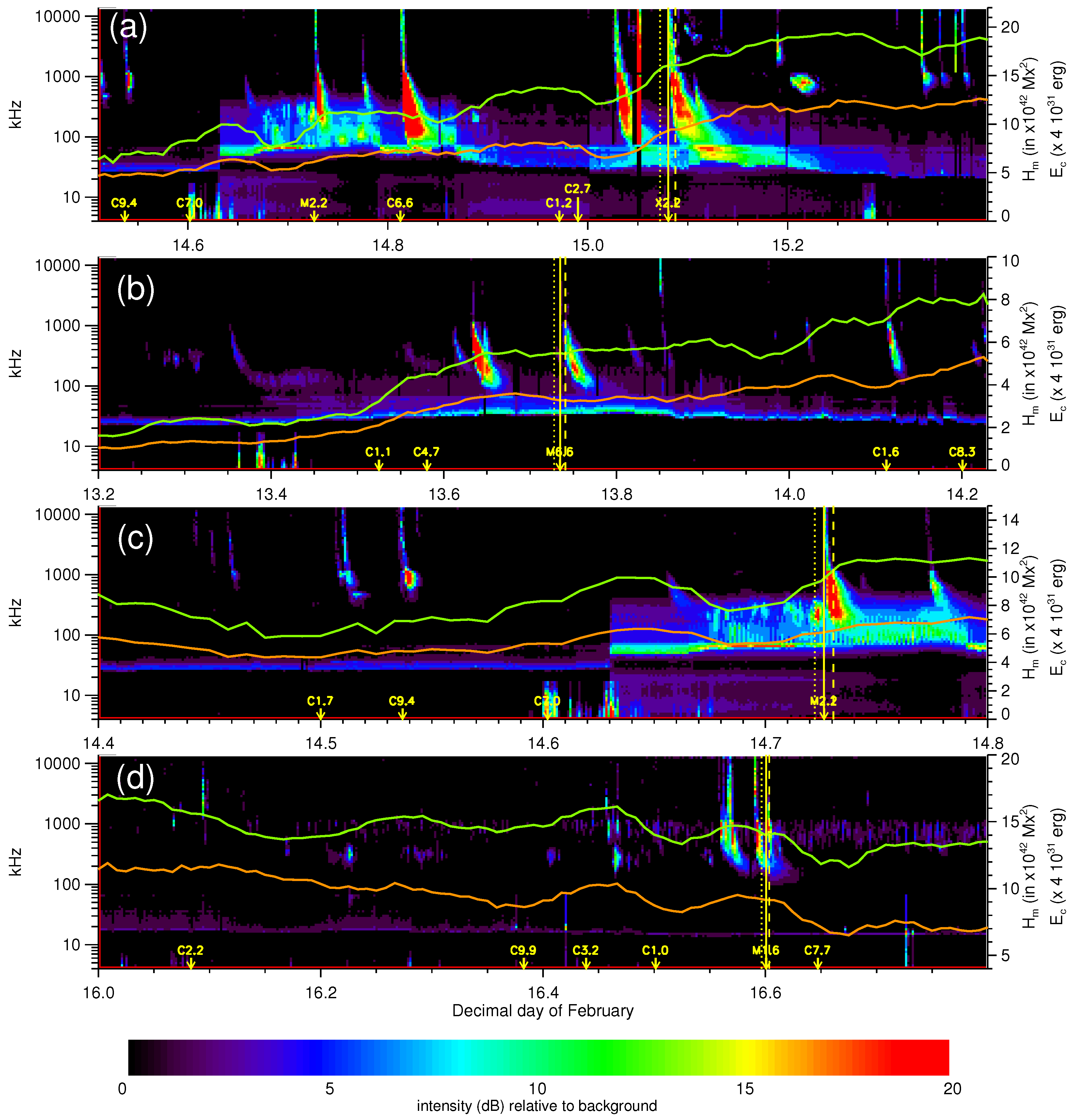
4.3. Direct Correlations between Parameters
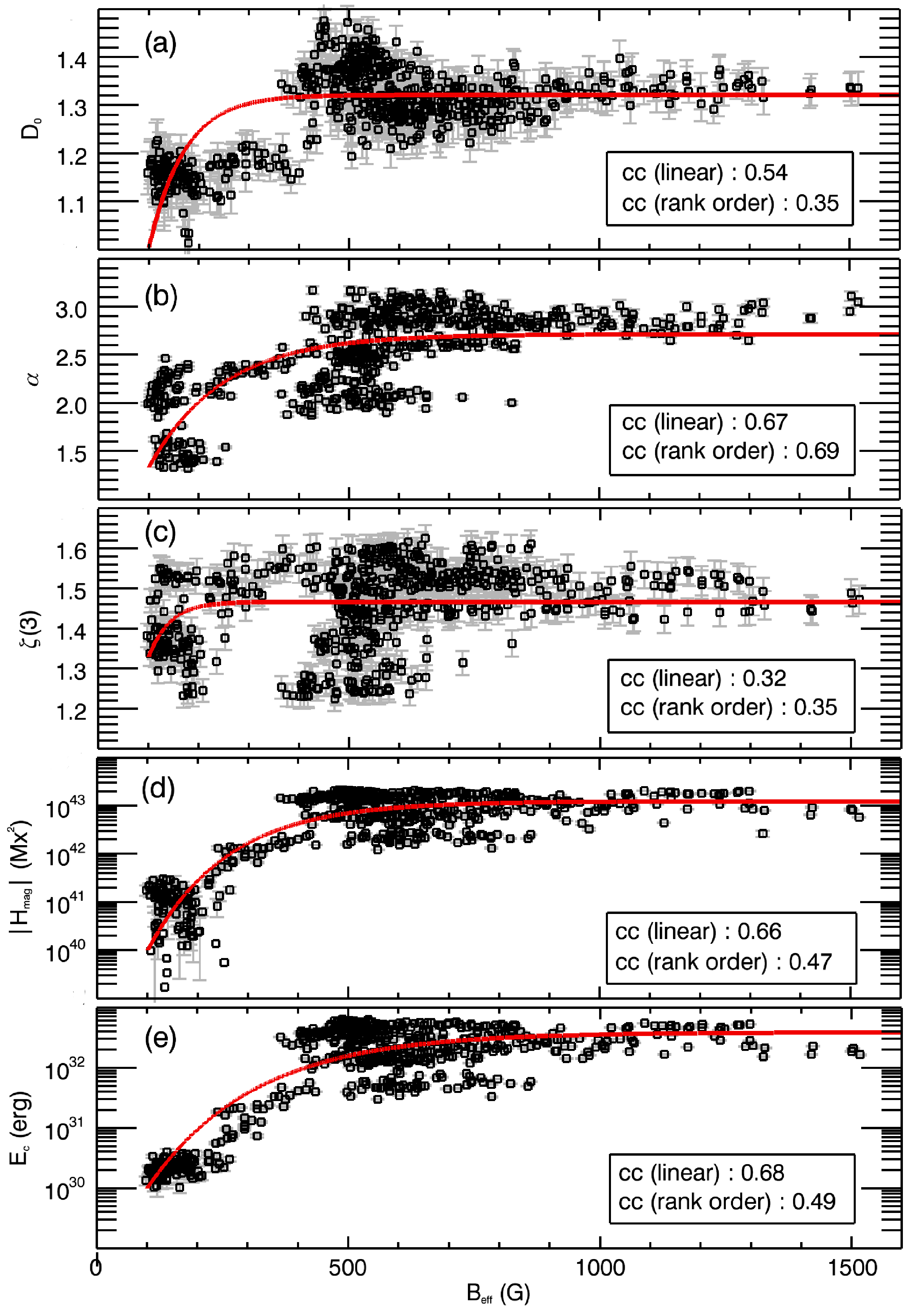
5. Summary and Conclusions
Acknowledgments
Conflicts of Interest
References and Notes
- Georgoulis, M.K. On Our Ability to Predict Major Solar Flares. In The Sun: New Challenges, Astrophysics and Space Science Proceedings; Obridko, V.N., Georgieva, K., Nagovitsyn, Y.A., Eds.; Springer-Verlag: Berlin/Heidelberg, Germany, 2012; pp. 93–104. [Google Scholar]
- Barnes, G.; Leka, K.D. Evaluating the performance of solar flare forecasting methods. Astrophys. J. 2008, 688, L107–L110. [Google Scholar] [CrossRef]
- Leka, K.D.; Barnes, G. Solar Flare Forecasting: A “State of the Field" Report for Researchers. In Proceedings of the AAS/SPD Meeting #44, Bozeman, MT, USA, 8–12 July 2013. Abstract # 100.82.
- Georgoulis, M.K. Are solar active regions with major flares more fractal, multifractal, or turbulent than others? Solar Phys. 2012, 276, 161–181. [Google Scholar] [CrossRef]
- Uritsky, V.M.; Paczuski, M.; Davila, J.M.; Jones, S.I. Coexistence of self-organized criticality and intermittent turbulence in the solar corona. Phys. Rev. Lett. 2007, 99, 025001. [Google Scholar] [CrossRef] [PubMed]
- Bak, P. How Nature Works: The Science of Self-Organized Criticality; Springer Verlag: New York, NY, USA, 1996. [Google Scholar]
- Nicolis, G.; Prigogine, I. Exploring Complexity. An Introduction; W. H. Freeman: New York, NY, USA, 1989. [Google Scholar]
- Uritsky, V.M.; Davila, J.M.; Ofman, L.; Coyner, A.J. Stochastic coupling of solar photosphere and corona. Astrophys. J. 2013, 769, 62:1–62:20. [Google Scholar] [CrossRef]
- Dimitropoulou, M.; Georgoulis, M.; Isliker, H.; Vlahos, L.; Anastasiadis, A.; Strintzi, D.; Moussas, X. The correlation of fractal structures in the photospheric and the coronal magnetic field. Astron. Astrophys. 2009, 505, 1245–1253. [Google Scholar] [CrossRef]
- Bloomfield, D.S.; Higgins, P.A.; McAteer, R.T.J.; Gallagher, P.T. Toward reliable benchmarking of solar flare forecasting methods. Astrophys. J. 2012, 747, L41:1–L41:7. [Google Scholar] [CrossRef]
- Leka, K.D.; Barnes, G.; The Flare Forecasting Comparison Group. The Second NWRA Flare-Forecasting Comparison Workshop: Methods Compared and Methodology. In Proceedings of the AAS/SPD Meeting #44, Bozeman, MT, USA, 8–12 July 2013. Abstract # 100.81.
- Georgoulis, M.K.; Tziotziou, K.; Raouafi, N.-E. Magnetic energy and helicity budgets in the active-region solar corona. II. Nonlinear force-free approximation. Astrophys. J. 2012, 759, 1:1–1:18. [Google Scholar] [CrossRef]
- Scherrer, P.H.; Schou, J.; Bush, R.I.; Kosovichev, A.G.; Bogart, R.S.; Hoeksema, J.T.; Liu, Y.; Duvall, T.L.; Zhao, J.; Title, A.M.; et al. The Helioseismic and Magnetic Imager (HMI) investigation for the Solar Dynamics Observatory (SDO). Solar Phys. 2012, 275, 207–227. [Google Scholar] [CrossRef]
- Pesnell, W.D.; Thompson, B.J.; Chamberlin, P.C. The Solar Dynamics Observatory (SDO). Solar Phys. 2012, 275, 3–15. [Google Scholar] [CrossRef]
- Lemen, J.R.; Title, A.M.; Akin, D.J.; Boerner, P.F.; Chou, C.; Drake, J.F.; Duncan, D.W.; Edwards, C.G.; Friedlaender, F.M.; Heyman, G.F.; et al. The Atmospheric Imaging Assembly (AIA) on the Solar Dynamics Observatory (SDO). Solar Phys. 2012, 275, 17–40. [Google Scholar] [CrossRef]
- Liu, C.; Deng, N.; Liu, R.; Lee, J.; Wiegelmann, T.; Jing, J.; Xu, Y.; Wang, S.; Wang, H. Rapid changes of photospheric magnetic field after tether-cutting reconnection and magnetic implosion. Astrophys. J. 2012, 745, L4:1–L4:7. [Google Scholar] [CrossRef]
- Schrijver, C.J.; Aulanier, G.; Title, A.M.; Pariat, E.; Delannée, C. The 2011 February 15 X2 flare, ribbons, coronal front, and mass ejection: Interpreting the three-dimensional views from the Solar Dynamics Observatory and STEREO guided by magnetohydrodynamic flux-rope modeling. Astrophys. J. 2011, 738, 167:1–167:23. [Google Scholar]
- Sun, X.; Hoeksema, J.T.; Liu, Y.; Wiegelmann, Th.; Hayashi, K.; Chen, Q.; Thalmann, J. Evolution of magnetic field and energy in a major eruptive active region based on SDO/HMI observation. Astrophys. J. 2012, 748, 77:1–77:15. [Google Scholar]
- Vemareddy, P.; Ambastha, A.; Maurya, R.A. On the role of rotating sunspots in the activity of solar active region NOAA 11158. Astrophys. J. 2012, 761, 60:1–60:13. [Google Scholar] [CrossRef]
- Tziotziou, K.; Georgoulis, M.K.; Liu, Y. Interpreting eruptive behavior in NOAA AR 11158 via the region’s magnetic energy and relative-helicity budgets. Astrophys. J. 2013, 772, 115:1–115:18. [Google Scholar] [CrossRef]
- Borrero, J.M.; Tomczyk, S.; Kubo, M.; Socas-Navarro, H.; Schou, J.; Couvidat, S.; Bogart, R. VFISV: Very fast inversion of the stokes vector for the helioseismic and magnetic imager. Solar Phys. 2011, 273, 267–293. [Google Scholar] [CrossRef]
- Leka, K.D.; Barnes, G.; Crouch, A.D.; Metcalf, T.R.; Gary, G.A.; Jing, J.; Liu, Y. Resolving the 180° ambiguity in solar vector magnetic field data: Evaluating the effects of noise, spatial resolution, and method assumptions. Solar Phys. 2009, 260, 83–108. [Google Scholar] [CrossRef]
- Georgoulis, M.K. Comment on “Resolving the 180° ambiguity in solar vector magnetic field data: evaluating the effects of noise, spatial resolution, and method assumptions”. Solar Phys. 2012, 276, 423–440. [Google Scholar] [CrossRef]
- Georgoulis, M.K. A New Technique for a routine azimuth disambiguation of solar vector magnetograms. Astrophys. J. 2005, 629, L69–L72. [Google Scholar] [CrossRef]
- Metcalf, Th.R.; Leka, K.D.; Barnes, G.; Lites, B.W.; Georgoulis, M.K.; Pevtsov, A.A.; Balasubramaniam, K.S.; Gary, G.A.; Jing, J.; Li, J.; et al. An overview of existing algorithms for resolving the 180° ambiguity in vector magnetic fields: Quantitative tests with synthetic data. Solar Phys. 2006, 237, 267–296. [Google Scholar] [CrossRef]
- Gary, G.A.; Hagyard, M.J. Transformation of vector magnetograms and the problems associated with the effects of perspective and the azimuthal ambiguity. Solar Phys. 1990, 126, 21–36. [Google Scholar] [CrossRef]
- Martens, P.C.H.; Attrill, G.D.R.; Davey, A.R.; Engell, A.; Farid, S.; Grigis, P.C.; Kasper, J.; Korreck, K.; Saar, S.H.; Savcheva, A.; et al. Computer vision for the Solar Dynamics Observatory (SDO). Solar Phys. 2012, 275, 79–113. [Google Scholar] [CrossRef]
- Hurlburt, N.; Cheung, M.; Schrijver, C.; Chang, L.; Freeland, S.; Green, S.; Heck, C.; Jaffey, A.; Kobashi, A.; Schiff, D.; et al. Heliophysics event knowledgebase for the Solar Dynamics Observatory (SDO) and beyond. Solar Phys. 2012, 275, 67–78. [Google Scholar] [CrossRef]
- Abramenko, V.I.; Yurchyshyn, V.B.; Wang, H.; Spirock, T.J.; Goode, P.R. Scaling behavior of structure functions of the longitudinal magnetic field in active regions on the sun. Astrophys. J. 2002, 577, 487–495. [Google Scholar] [CrossRef]
- Abramenko, V.I. Pre-flare changes in the turbulence regime for the photospheric magnetic field in a solar active region. Astron. Rep. 2003, 47, 151–160. [Google Scholar] [CrossRef]
- Abramenko, V.I.; Yurchyshyn, V.; Wang, H. Intermittency in the photosphere and corona above an active region. Astrophys. J. 2008, 681, 1669–1696. [Google Scholar] [CrossRef]
- McAteer, R.T.J.; Gallagher, P.T.; Ireland, J. Statistics of active region complexity: A large-scale fractal dimension survey. Astrophys. J. 2005, 631, 628–635. [Google Scholar] [CrossRef]
- Abramenko, V.I. Relationship between magnetic power spectrum and flare productivity in solar active regions. Astrophys. J. 2005, 629, 1141–1149. [Google Scholar] [CrossRef]
- Abramenko, V.I.; Yurchyshyn, V. Magnetic energy spectra in solar active regions. Astrophys. J. 2010, 720, 717–722. [Google Scholar] [CrossRef]
- Kolmogorov, A.N. Equations of turbulent motion in an incompressible fluid. Acad. Nauk USSR Ser. Fiz. 1942, 6, 56–58. [Google Scholar]
- Kraichnan, R.H. Inertial-range spectrum of hydromagnetic turbulence. Phys. Fluids 1965, 8, 1385–1387. [Google Scholar] [CrossRef]
- Frisch, U. Turbulence, the Legacy of A. N. Kolmogorov; Cambridge University Press: Cambridge, UK, 1995. [Google Scholar]
- Georgoulis, M.K. Turbulence in the solar atmosphere: Manifestations and diagnostics via solar image processing. Solar Phys. 2005, 228, 5–27. [Google Scholar] [CrossRef]
- McAteer, R.T.J.; Young, C.A.; Ireland, J.; Gallagher, P.T. The bursty nature of solar flare X-Ray emission. Astrophys. J. 2007, 662, 691–700. [Google Scholar] [CrossRef]
- McAteer, R.T.J. Private Communication, 2013.
- Schrijver, C.J. A characteristic magnetic field pattern associated with all major solar flares and its use in flare forecasting. Astrophys. J. 2007, 655, L117–L120. [Google Scholar] [CrossRef]
- Falconer, D.A.; Moore, R.L.; Gary, G.A.; Adams, M. The “Main Sequence" of explosive solar active regions: Discovery and interpretation. Astrophys. J. 2009, 700, L166–L169. [Google Scholar] [CrossRef]
- Mason, J.P.; Hoeksema, J.T. Testing automated solar flare forecasting with 13 years of michelson doppler imager magnetograms. Astrophys. J. 2012, 723, 634–640. [Google Scholar] [CrossRef]
- Schrijver, C.J. Driving major solar flares and eruptions: A review. Adv. Space Res. 2009, 43, 739–755. [Google Scholar] [CrossRef]
- Leka, K.D.; Barnes, G. Photospheric magnetic field properties of flaring versus flare-quiet active regions. I. Data, general approach, and sample results. Astrophys. J. 2003, 595, 1277–1295. [Google Scholar] [CrossRef]
- Georgoulis, M.K.; Rust, D.M. Quantitative forecasting of major solar flares. Astrophys. J. 2007, 661, L109–L112. [Google Scholar] [CrossRef]
- Bobra, M.G.; Georgoulis, M.K.; Hoeksema, J.T. Calculating Flaring Potential in Solar Active Regions Using SDO/HMI Vector Magnetic Field Data. In Proceedings of the First LWS/SDO Workshop, Squaw Valley, CA, USA, 1–5 May 2011.
- Higgins, P.A. Private Communication, 2013.
- Barnes, G.; Longcope, D.W.; Leka, K.D. Implementing a magnetic charge topology model for solar active regions. Astrophys. J. 2005, 629, 561–571. [Google Scholar] [CrossRef]
- Georgoulis, M.K.; Titov, V.S.; Mikić, Z. Non-neutralized electric current patterns in solar active regions: Origin of the shear-generating lorentz force. Astrophys. J. 2012, 761, 1:1–1:16. [Google Scholar] [CrossRef]
- Press, W.H.; Teukolsky, S.A.; Flannery, B.P.; Vetterling, W.T. Numerical Recipes in Fortran. The Art of Scientific Computing; Cambridge University Press: New York, NY, USA, 1992. [Google Scholar]
- Welsch, B.T.; Abbett, W.P.; de Rosa, M.L.; Fisher, G.H.; Georgoulis, M.K.; Kusano, K.; Longcope, D.W.; Ravindra, B.; Schuck, P.W. Tests and comparisons of velocity-inversion techniques. Astrophys. J. 2007, 670, 1434–1452. [Google Scholar] [CrossRef]
- De Rosa, M.L.; Schrijver, C.J.; Barnes, G.; Leka, K.D.; Lites, B.W.; Aschwanden, M.J.; Amari, T.; Canou, A.; McTiernan, J.M.; Régnier, S.; et al. A critical assessment of nonlinear force-free field modeling of the solar corona for active region 10953. Astrophys. J. 2009, 696, 1780–1791. [Google Scholar] [CrossRef]
- Metcalf, Th.R.; De Rosa, M.L.; Schrijver, C.J.; Barnes, G.; van Ballegooijen, A.A.; Wiegelmann, T.; Wheatland, M.S.; Valori, G.; McTtiernan, J.M. Nonlinear force-free modeling of coronal magnetic fields. II. Modeling a filament arcade and simulated chromospheric and photospheric vector fields. Solar Phys. 2008, 247, 269–299. [Google Scholar] [CrossRef]
- Schrijver, C.J.; De Rosa, M.L.; Metcalf, Th. R.; Liu, Y.; McTiernan, J.; Régnier, S.; Valori, G.; Wheatland, M.S.; Wiegelmann, T. Nonlinear force-free modeling of coronal magnetic fields Part I: A quantitative comparison of methods. Solar Phys. 2006, 235, 161–190. [Google Scholar] [CrossRef]
- McClymont, A.N.; Fisher, G.H. On the Mechanical Energy Available to Drive Solar Flares. In Yosemite Conference on Outstanding Problems in Solar Plasma Physics: Theory and Instrumentation; Waite, J.H., Burch, J.L., Moore, R.L., Eds.; AGU: Washington, DC, USA, 1989; pp. 219–225. [Google Scholar]
- Georgoulis, M.K.; LaBonte, B.J. Magnetic energy and helicity budgets in the active region solar corona. I. Linear force-free approximation. Astrophys. J. 2007, 671, 1034–1050. [Google Scholar] [CrossRef]
- Bougeret, J.-L.; Kaiser, M.L.; Kellogg, P.J.; Manning, R.; Goetz, K.; Monson, S.J.; Monge, N.; Friel, L.; Meetre, C.A.; Perche, C.; et al. Waves: The radio and plasma wave investigation on the wind spacecraft. Space Sci. Rev. 1995, 71, 231–263. [Google Scholar] [CrossRef]
- Klassen, A.; Aurass, H.; Mann, G.; Thompson, B. J. Catalogue of the 1997 SOHO-EIT coronal transient waves and associated type II radio burst spectra. Astron. Astrophys. Suppl. 2000, 141, 357–369. [Google Scholar] [CrossRef]
- Yashiro, S.; Gopalswamy, N.; Michalek, G.; St. Cyr, O.C.; Plunkett, S.P.; Rich, N.B.; Howard, R.A. A catalog of white light coronal mass ejections observed by the SOHO spacecraft. J. Geophys. Res. 2004, 109, A07105. [Google Scholar] [CrossRef]
- Olmedo, O.; Zhang, J.; Wechsler, H.; Poland, A.; Borne, K. Automatic detection and tracking of coronal mass ejections in coronagraph time series. Solar Phys. 2008, 248, 485–499. [Google Scholar] [CrossRef]
- Robbrecht, E.; Berghmans, D. Automated recognition of coronal mass ejections (CMEs) in near-real-time data. Astron. Astrophys. 2004, 425, 1097–1106. [Google Scholar] [CrossRef]
- Conlon, P.A.; McAteer, R.T.J.; Gallagher, P.T.; Fennell, L. Quantifying the evolving magnetic structure of active regions. Astrophys. J. 2010, 722, 577–585. [Google Scholar] [CrossRef]
- Howe, R.; Jain, K.; Bogart, R.S.; Haber, D.A.; Baldner, C.S. Two-dimensional helioseismic power, phase, and coherence spectra of solar dynamics observatory photospheric and chromospheric observables. Solar Phys. 2012, 281, 533–549. [Google Scholar] [CrossRef]
- Liu, Y.; Schuck, P.W. Magnetic energy and helicity in two emerging active regions in the sun. Astrophys. J. 2012, 761, 105:1–105:15. [Google Scholar] [CrossRef]
- Tziotziou, K.; Georgoulis, M.K.; Raouafi, N.-E. The magnetic energy-helicity diagram of solar active regions. Astrophys. J. 2012, 759, L4:1–L4:7. [Google Scholar] [CrossRef]
- Ahmed, O.W.; Qahwaji, R.; Colak, T.; Higgins, P.A.; Gallagher, P.T.; Bloomfield, D.S. Solar flare prediction using advanced feature extraction, machine learning, and feature selection. Solar Phys. 2013, 283, 157–175. [Google Scholar] [CrossRef]
- Song, H.; Tan, C.; Jing, J.; Wang, H.; Yurchyshyn, V.; Abramenko, V. Statistical assessment of photospheric magnetic features in imminent solar flare predictions. Solar Phys. 2009, 254, 101–125. [Google Scholar] [CrossRef]
- Yu, D.; Huang, X.; Hu, Q.; Zhou, R.; Wang, H.; Cui, Y. Short-term solar flare prediction using multiresolution predictors. Astrophys. J. 2010, 709, 321–326. [Google Scholar] [CrossRef]
- Leka, K.D.; Barnes, G. Photospheric magnetic field properties of flaring versus flare-quiet active regions. IV. A statistically significant sample. Astrophys. J. 2007, 656, 1173–1186. [Google Scholar] [CrossRef]
- DeVore, C.R. Magnetic helicity generation by solar differential rotation. Astrophys. J. 2000, 539, 944–953. [Google Scholar] [CrossRef]
- Georgoulis, M.K.; Rust, D.M.; Pevtsov, A.A.; Bernasconi, P.N.; Kuzanyan, K.M. Solar magnetic helicity injected into the heliosphere: Magnitude, balance, and periodicities over solar cycle 23. Astrophys. J. 2009, 705, L48–L52. [Google Scholar] [CrossRef]
- Hudson, H.S.; Fletcher, L.; Fisher, G.H.; Abbett, W.P.; Russell, A. Momentum distribution in solar flare processes. Solar Phys. 2012, 277, 77–88. [Google Scholar] [CrossRef]
- Sudol, J.J.; Harvey, J.W. Longitudinal magnetic field changes accompanying solar flares. Astrophys. J. 2005, 635, 647–658. [Google Scholar] [CrossRef]
- Wang, H.; Liu, C. Observational evidence of back reaction on the solar surface associated with coronal magnetic restructuring in solar eruptions. Astrophys. J. 2010, 716, L195–L199. [Google Scholar] [CrossRef]
- Fisher, G.H.; Bercik, D.J.; Welsch, B.T.; Hudson, H.S. Global forces in eruptive solar flares: The lorentz force acting on the solar atmosphere and the solar interior. Solar Phys. 2012, 277, 59–76. [Google Scholar] [CrossRef]
- Petrie, G.J.D. A spatio-temporal description of the abrupt changes in the photospheric magnetic and lorentz-force vectors during the 15 February 2011 X2.2 flare. Solar Phys. 2013, 287, 415–440. [Google Scholar] [CrossRef]
- Reinard, A.A.; Henthorn, J.; Komm, R.; Hill, F. Evidence that temporal changes in solar subsurface helicity precede active region flaring. Astrophys. J. 2010, 710, L121–L125. [Google Scholar] [CrossRef]
© 2013 by the author; licensee MDPI, Basel, Switzerland. This article is an open access article distributed under the terms and conditions of the Creative Commons Attribution license (http://creativecommons.org/licenses/by/3.0/).
Share and Cite
Georgoulis, M.K. Toward an Efficient Prediction of Solar Flares: Which Parameters, and How? Entropy 2013, 15, 5022-5052. https://doi.org/10.3390/e15115022
Georgoulis MK. Toward an Efficient Prediction of Solar Flares: Which Parameters, and How? Entropy. 2013; 15(11):5022-5052. https://doi.org/10.3390/e15115022
Chicago/Turabian StyleGeorgoulis, Manolis K. 2013. "Toward an Efficient Prediction of Solar Flares: Which Parameters, and How?" Entropy 15, no. 11: 5022-5052. https://doi.org/10.3390/e15115022



